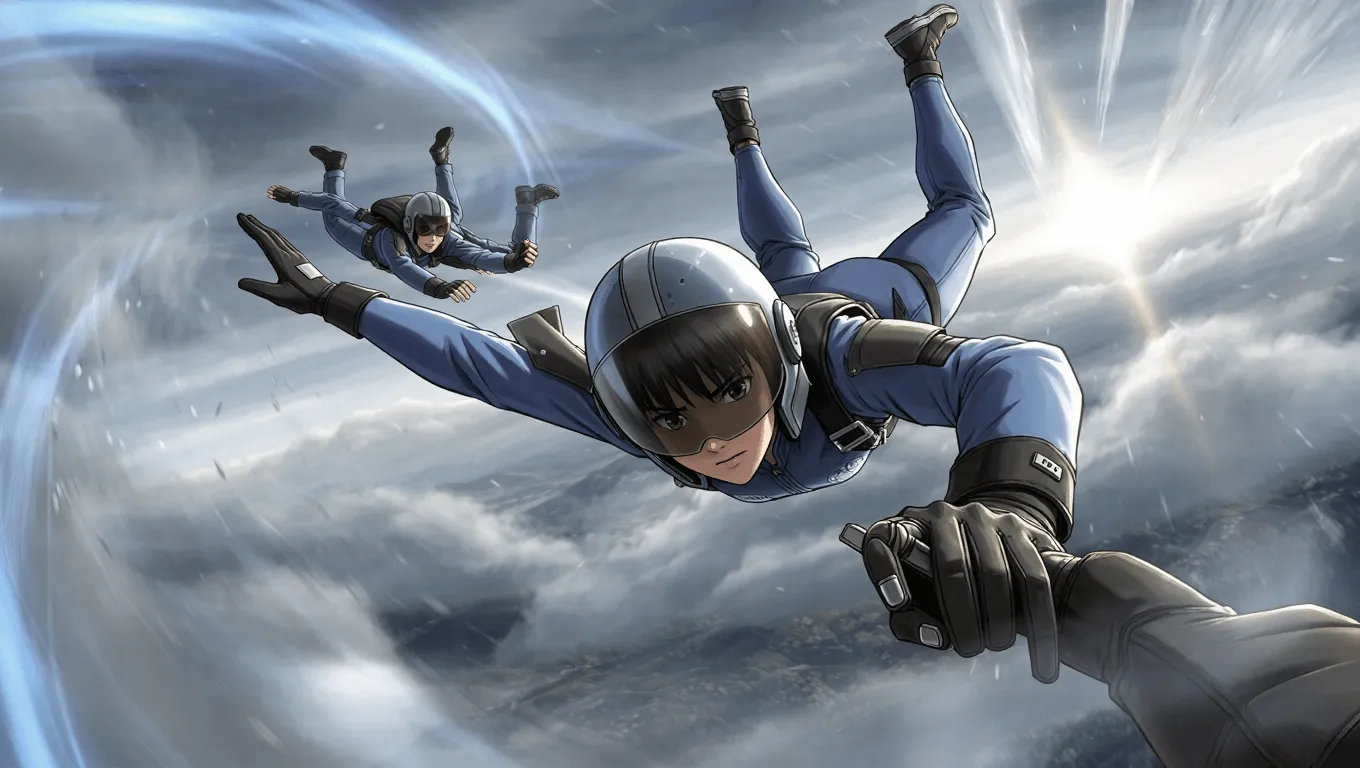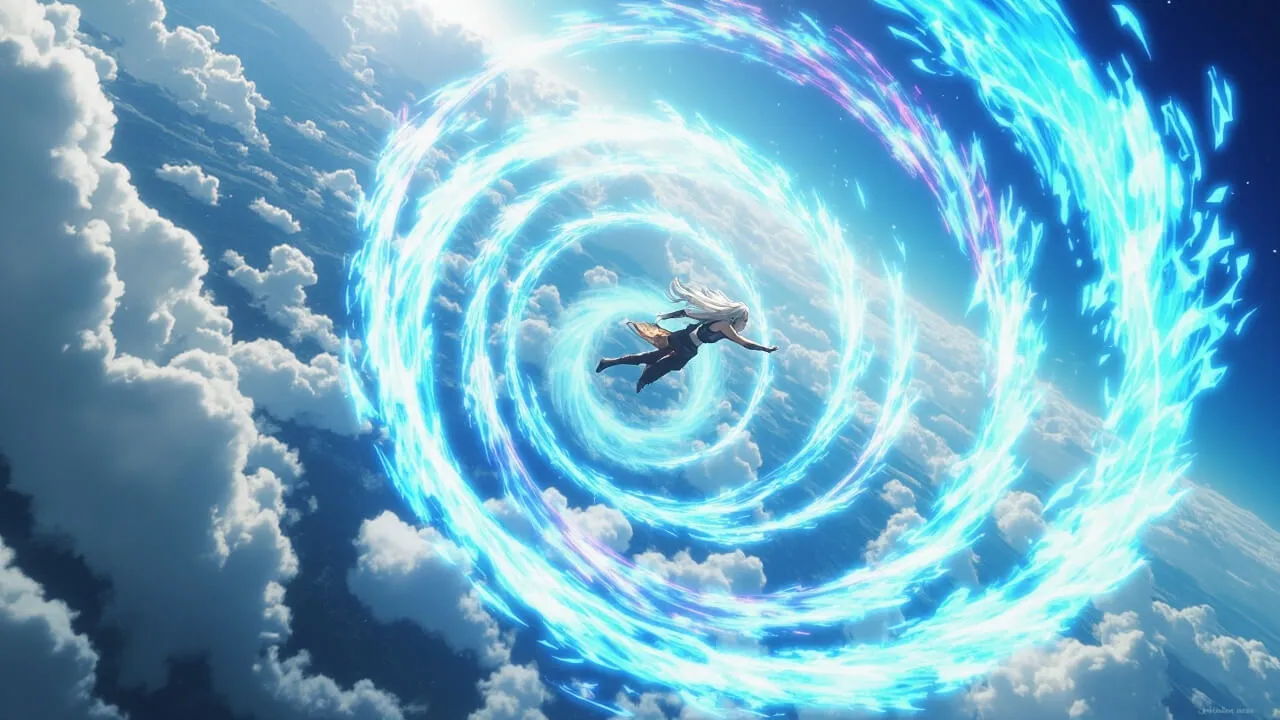Aerial Mastery

Aerial Mastery Video Demo 🎬
Table of Contents
What Is Aerial Mastery
Aerial Mastery is the superpower of complete command over movement, orientation, and tactics in the air. Users with Aerial Mastery don’t just fly; they dominate three-dimensional space with precision, fluidity, and battlefield awareness. Unlike basic flight, this power blends advanced aerodynamics, spatial cognition, balance, and air-combat proficiency—often enhanced by micro-adjustments to lift, drag, and inertia. It shows up in many forms, from winged flight to levitation and jet-propelled maneuvering, but the hallmark is the same: effortless agility and control at any altitude.
If you’re building a character or researching related powers, browse our full Superpower Wiki and try the Random Superpower Generator to spark new builds and team synergies.
Core Abilities of Aerial Mastery
Fine-Grained Flight Control
At its heart, Aerial Mastery refines flight into a toolkit. Users can hover with millimeter accuracy, execute instant stops, reverse vectoring in tight corridors, and maintain stable flight in turbulence. This goes beyond “fast” or “high”—it’s about precise control at any speed or angle, including inverted hover, lateral strafe, and corkscrew ascents.
Advanced Aerial Agility
Three-dimensional movement requires superior roll, pitch, and yaw management. Masters chain split-S turns, Immelmanns, and hammerheads like aerobatic pilots—only without a cockpit. They can transition from vertical climbs to zero-velocity pivots and dive recoveries without losing situational awareness.
Spatial Awareness and Air Combat IQ
Users perceive threats across a full 360° sphere, tracking trajectories, slipstreams, and blind-spot vectors. This “aerial sense” improves collision avoidance, approach timing, and multi-target engagement. In dogfights, it translates to unmatched positioning, feints, and terrain-assisted tactics (e.g., using rooftops, antennae, and cloud cover).
Micro-Aerokinetic Adjustments (Optional)
Not all wielders control wind, but many develop subtle air manipulation for stability and acceleration. By shaping boundary layers and wake vortices, they reduce drag and amplify lift, enabling short-burst accelerations and hyper-tight turns.
High-G Tolerance and Dynamic Balance
Aerial Mastery often includes physiological or energy-field adaptations to withstand sharp G-loads, rapid altitude shifts, and pressure changes. The user recovers from stalls and spins that would disorient ordinary fliers, preserving targeting accuracy during complex maneuvers.
Precision Landing and Takeoff
Silent entries through narrow openings, mid-air docking, and landing on moving platforms become routine. This extends to mid-air grapples, passenger rescues, and equipment retrieval without jarring impacts.
Weather Adaptation
Skilled users compensate for crosswinds, downdrafts, rain shear, and thermal columns. In extreme cases, they exploit environmental features: surfing thermals for lift, diving through cold fronts to mask signatures, or riding mountain waves for speed.
Application / Tactical Advantages in Combat
Air Supremacy and Position Control
Height, angle, and distance rule the fight. Aerial Mastery lets users dictate engagement range—closing rapidly to disrupt snipers or maintaining standoff distance to neutralize melee threats. They can cut escape routes, pressure from above, and set up vertical flanking maneuvers.
Precision Strikes and Intercepts
Because they can alter velocity vectors instantly, masters thread through debris fields, intercept projectiles, and deliver pinpoint hits mid-flight. Expect high success in hostage extractions, missile redirection, and drone interceptions.
Mobility-Based Defense
The air is a dynamic shield. Rapid vector shifts and rolling evasions reduce hit probability from ballistic fire, beam weapons, and thrown objects. Combined with micro-bursts, users can “phase” out of predicted aim paths without teleportation.
Multi-Terrain Operations
Urban canyons, forest canopies, cliff faces, and stadium domes all become tactical playgrounds. Aerial Mastery maximizes cover transitions—ducking behind billboards, perching under bridges, or using wind shadows to break line of sight.
Reconnaissance and Command of View
Aerial scouts create real-time battlefield maps, identify traps, and spot reinforcements sooner. Vertical observation outperforms ground patrols, enabling rapid threat classification and target designation for allies.
Level: Level 1 🏙️, Level 2 🌇, Level 3 🌃
Level 1: Skilled Flier

Beginners master stable hover, smooth acceleration, and reliable landings. They can weave through open spaces and avoid obstacles at moderate speed. Combat value centers on mobility: quick repositioning, simple evasion, and short-range recon. Weather affects them; high winds and heavy rain reduce precision.
Typical feats
-
Hover within a 1–2 meter drift radius
-
Execute basic climbs/descents and 90° turns
-
Evade small-arms fire intermittently
-
Carry one passenger for brief distances with careful balance
Training goals
-
Develop vestibular resilience (anti-vertigo drills)
-
Practice slow-speed control and obstacle courses
-
Learn vertical flanking and rooftop landings
Level 2: Combat Aviator

At this tier, Aerial Mastery enables high-speed aerobatics, tight turns, and reliable mid-air grapples. The user reads airflow cues and anticipates threats, enabling accurate intercepts and sustained dogfights. Moderate turbulence is manageable.
Typical feats
-
Precision hover within 30–50 cm drift
-
Split-S and Immelmann chains without loss of orientation
-
Catch/redirect thrown explosives or drones
-
Mid-air passenger handoff and equipment retrieval
-
Stable fire from the air with handheld ranged weapons
Training goals
-
Live-fire evasion patterns and predictive dodging
-
Energy management: surge, coast, and recovery cycles
-
Crosswind landings on moving vehicles
Level 3: Ace of the Skies

This is peak Aerial Mastery—pinpoint micro-corrections at any speed, surgical interceptions, and battlefield orchestration from above. The ace can leverage minimal air currents for stealth, perform sudden vector inversions, and operate under extreme conditions. In a team, they function as airborne command and control, tagging targets and coordinating vertical assault corridors.
Typical feats
-
Millimeter-precise hover and whisper-quiet landings
-
Multi-target interceptions within seconds
-
High-G maneuvers with negligible disorientation
-
Use environmental airflow (thermals, mountain waves) for free energy
-
Seamless integration with recon, artillery spotting, and extraction ops
Training goals
-
Advanced counter-sniper flight paths and decoy trails
-
Micro-aerokinetic shaping (if available) for drag reduction
-
Night-ops navigation using limited visual cues
Limitations of Using the Aerial Mastery
Environmental Exposure
Lightning, ash clouds, freezing rain, and microbursts can degrade performance. Prolonged operations at altitude risk hypoxia (unless the user has enhanced physiology). Dense smoke and dust impair visibility and sensor performance.
Energy and Endurance Costs
Sustained high-speed maneuvering is metabolically expensive. Without energy reserves or supportive tech, fatigue leads to sloppier turns, wider arcs, and slower reaction windows.
Payload and Momentum
Carrying heavy passengers or gear reduces agility and increases stopping distance. Even with perfect control, momentum laws apply—rapid deceleration from top speeds can stress the body or equipment.
Line-of-Sight Dependencies
While verticality expands view, it can also expose the user to long-range fire. Open-sky silhouettes make for easy tracking by radar, optics, or sharpshooters when stealth measures aren’t in play.
Tech Reliance (For Gear-Based Fliers)
Jet packs, wingsuits, gliders, or grav-boots risk mechanical failure, EMP disruption, or fuel depletion. Aerial Mastery can offset pilot error but not catastrophic equipment loss.
Weakness Against What Other Superpowers
Gravity Manipulation and Inertial Control
Opponents who alter gravity wells, increase weight, or scramble inertia can stall or pin aerial combatants. Forced descents and sudden weight spikes cancel agility advantages.
Aerokinesis Nullification or Vacuum Generation
Wind dampening, pressure bubbles, or temporary vacuums remove the air the user depends on for lift or control—especially for winged fliers.
Weather Domination
Hurricanes, blizzards, or targeted lightning complicate flight paths. Turbulence layers and downdrafts can trap the user, forcing ground engagement.
Magnetism and Technopathy (Against Gear-Based Fliers)
Magnetic fields can seize metal wings or jet components. Technopaths may hijack stabilization software, throttle controls, or HUDs mid-flight.
Sound and Vibration Attacks
Sonic bursts and vertigo induction can disorient the inner ear, corrupt balance, and degrade fine motor control, causing misjudged turns and altitude loss.
Restraint and Terrain Control
Webbing, chain projection, or sudden growth of aerial obstacles (like hard-light walls) can snare or box in a flier, nullifying maneuver space.
Synergistic Power Combos
Aerokinesis + Aerial Mastery
Combining wind control with aerial prowess unlocks instant acceleration, silent lift, and shockwave strikes. Users can carry allies on stable air platforms, create wind shields, and generate slipstreams for team speed boosts.

Precognition or Enhanced Reflexes
Seeing a half-second into the future, or simply reacting faster, turns dodging into an art form. Predictive evasion and pre-aimed intercepts make projectile defenses nearly flawless.

Enhanced Vision and Spatial Mapping
Eagle-eye acuity, thermal vision, or radar-like mapping turns the sky into a tactical command post. Users locate ambushes, spot electronic signatures, and tag threats for allies.

Force Fields or Hard-Light Constructs
Mid-air cover changes everything: floating barricades, ramps, and platforms enable aerial parkour, safe landings, and staging points for teams without flight.

Telekinesis
A telekinetic boost cancels momentum, halts dives, or slingshots the user around corners. It also enables safe passenger rescues and controlled debris redirection during urban combat.

Weather Control
Micro-climate bubbles stabilize turbulent air around the user, enabling sniping platforms in storm conditions and stealth approaches through cloud cover.

Sonic or Shockwave Generation
Sonic cones, boom-kicks, and pressure-ring attacks pair well with vertical passes. The user can dive, strike, and ride the expanding shock to reposition instantly.

Known Users
-
Warren Worthington III (Angel) — a classic winged hero whose battlefield role often centers on aerial agility and rapid rescue. Learn more about Angel.
-
Sam Wilson (Falcon) — a jet-wing tactician who mixes air superiority with reconnaissance and drone coordination. Profile.
-
Hawkman — various incarnations showcase nth-metal flight with high-impact aerial combat. Character overview.
-
Carol Danvers — known for extreme-speed flight and high-G dogfights in space and atmosphere. Read about the character.
-
Vulture (Adrian Toomes) — a villainous application of flight engineering and aerial ambush tactics. More details.
Exploring Aerial Mastery alongside related powers? Check the broader Superpower Wiki and roll for inspiration with the Random Superpower Generator to discover unexpected team synergies and counters.
